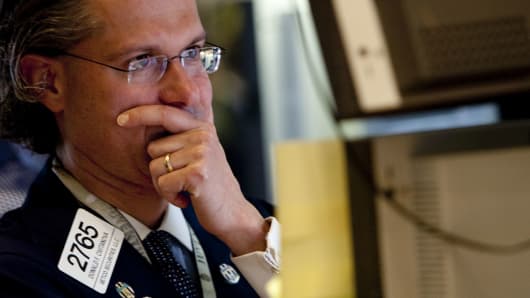Wednesday is the one-year anniversary of the Aug. 24 "flash crash," in which markets fell precipitously in early trading. Here are some of the biggest recent crashes that have affected trading on the U.S.'s biggest exchanges.
Four-digit drop: Aug. 24, 2015
Termed "Black Monday" in Asia, August 24, 2015 showed the increasing interconnectedness of global markets. A selloff in Asia triggered drop offs in European and U.S. stock futures before the U.S. markets opened. The Dow began the trading day down more than 1000 points but recovered half of that in the first minutes of trading. A rocky day and steep drop in the minutes before closing left the index down 588 points at the end of the day.
In the first 15 minutes of trading, 20 percent of S&P 500 companies and 40 percent of Nasdaq composite companies hit lows that were 10 percent below the previous close.
The early sell off was due partly to fears about China's economic slowdown and uncertainty around the Federal Reserve's policy on raising interest rates. Those fears led to traders dumping stocks early when there weren't a lot of buyers, which likely triggered high-speed trading models to shut down when they noticed unusual pricing.
The day led the NYSE to curb its use of its controversial Rule 48 which observers say exacerbated volatility.
Lunch-hour halt the NYSE: July 9, 2015
On July 9, 2015, the New York Stock Exchange went down for four hours in midday trading, starting around 11:30 a.m. Investors were already reeling from China's stock market meltdown and the Greek debt crisis, and the outage just heightened the sense of chaos in the market.
The NYSE suspended trading due to residual "communication issues" between customer gateways and trading units following a software update. After a shutdown of nearly four hours, the exchange fully restarted at 3:10 p.m.
"It's not a good day, and I don't feel good for our customers who are having to deal with the fallout," NYSE President Thomas Farley told CNBC at the time.
Treasury freeze: Oct. 15, 2014
In early trading on October 15, 2014, the yield on the 10-year Treasury note fell about 30 basis points, from 2.13 percent to 1.86 percent from 9:00 a.m. to 9:36 a.m. Between 9:33 a.m. and 9:45 a.m., the yield saw a complete round trip down 16 basis points and then back up.
U.S. Treasurys are normally seen as safe, stable investments so any volatility can send ripples through investors' confidence.
There was no single cause for the Treasury flash crash, according to a report released in 2015 by a number of government agencies. Instead, a number of factors collided: A huge number of short positions unwound that day, market depth dropped following a disappointing retail sales data release that morning and increased "self trading" during the "event window" contributed.
Flash freeze: Aug. 22, 2013
Three years ago Monday, Nasdaq-listed securities fell offline for three hours and 11 minutes when the SIP (security information processor) failed just after noon. The SIP, which carries quotes and trades for the exchange, was overwhelmed by a sudden burst of largely stale quotes.
After much finger-pointing, Nasdaq accepted some responsibility for what happened, saying, "A number of these issues were clearly within the control of Nasdaq OMX." But it maintained that a "latent flaw" in the software snowballed when Arca, NYSE's electronic trading platform, trying to connect.
While the Nasdaq was down, no Nasdaq-listed stocks could be traded. Shares not listed on Nasdaq continued, but not on the Nasdaq platform.
"The fact we didn't see a larger dip on today's mess shows most investors are, for better or worse, becoming more comfortable with these mistakes," Ryan Derrick, senior technical analyst at Schaeffer's Investment Research told Reuters.
Facebook debut: May 18, 2012
Facebook's massive initial public offering on the Nasdaq in May 2012 raised $16 billion. It was the second-biggest U.S. stock offering ever. It was the biggest offering ever for Nasdaq, which had only handled three of the 25 biggest offers ever, including Facebook. The large size proved to be an issue: problems were big and immediate. Technical glitches left traders in the dark for hours, unclear as to which trades had actually gone through. There was a "design flaw" in the software that had been missed during testing.
Nasdaq programmers removed a few lines of software code, but that did not fix the root cause of the problem. Over 30,000 orders were stuck in the system for more than two hours, when they should have been executed or canceled.
A year later, Nasdaqagreed to pay the SEC a $10 million fine, on top of the $62 million it agreed to pay trading firms that sustained losses during the IPO. "We recognize that the cornerstone of a market is investor confidence," Nasdaq OMX CEO Robert Greifeld said at the time.
Flash crash: May 6, 2010
The May 6, 2010 "flash crash" saw the Dow Jones drop nearly 1,000 points in a matter of minutes. A report from the SEC and CFTC indicated that a single trading house attempted to sell $4.5 billion worth of S&P 500 futures.
The algorithm didn't specify a sell price or time frame, resulting in too many trades being put into the market, with not enough liquidity to properly absorb them. That led to a continuation of similar problems, spiraling out of control: more trades flooded the market, liquidity dried up even further, and trade volume became too high to handle.
Separate from the original $4.5 billion sell order, there were traders trying to manipulate electronic prices. One of those traders, according to regulators, was Navinder Singh Sarao. Earlier this year, a British judge ruled that Sarao could be extradited to the U.S. to face trial for his actions during the flash crash, because he allegedly kept entering bogus orders to manipulate price action, known as "spoofing" in the industry.






